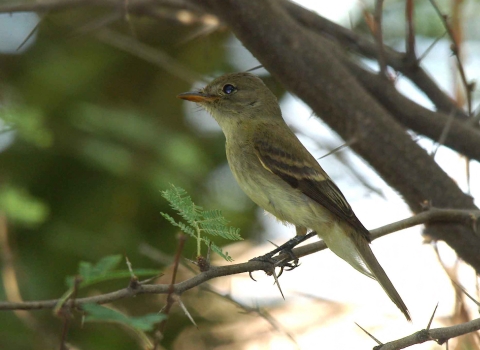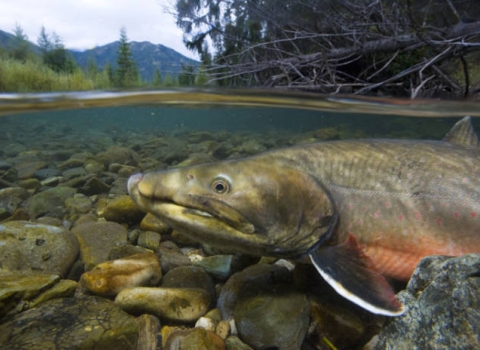The U.S. Fish and Wildlife Service today is celebrating the remarkable conservation achievements of waterfowl hunters and our unique American hunting heritage with the permanent addition of a theme for the Federal Migratory Bird Hunting and Conservation Stamp, commonly known as the Duck Stamp.
Beginning with the 2020 contest, the theme of “celebrating our waterfowl hunting heritage” will be incorporated into the contest rules. Each entry must depict an appropriate waterfowl hunting scene or include a hunting-related element.
“Duck Stamps have been one of America's most effective conservation tool for over 80 years,” said Secretary of the Interior David Bernhardt. “Showcasing the heritage of waterfowl hunting in Duck Stamps recognizes the importance of sportsmen and women to the North American Model of Wildlife Conservation.”
“Waterfowl hunters are the epitome of conservationists, as their purchase of Duck Stamps has enabled the conservation of millions of acres of wetland habitat,” said Aurelia Skipwith, Director of the U.S. Fish and Wildlife Service. “These wetlands provide places for a wide diversity of wildlife to thrive, while creating significant economic stimulus for rural communities. We honor that astonishing legacy, and what better way to do that than through the Duck Stamp itself.”
The change is part of a broader effort under Executive Order 13443 and Secretary of the Interior’s Order 3356 to “support and expand hunting and fishing, enhance conservation stewardship, improve wildlife management and increase outdoor recreation opportunities for all Americans.”
Participants must still adhere to existing contest regulations that require a live portrayal of one or more of the five eligible waterfowl species for that year (brant, gadwall, cinnamon teal, lesser scaup and red-breasted merganser for 2020) as the dominant foreground feature. Contestants will be judged on the quality of their art and how well they illustrate the theme. The next contest winner’s art will be made into the 2021-2022 Duck Stamp.
While waterfowl hunters 16 years of age or older are required to purchase a stamp each hunting season, anyone can buy one and contribute to conservation. Some 1.5 million stamps are sold each year, and as of 2019, Federal Duck Stamps have generated more than $1.1 billion for the preservation of more than 6 million acres of waterfowl habitat in the United States. A current Federal Duck Stamp is also a free pass into any national wildlife refuge national wildlife refuge
A national wildlife refuge is typically a contiguous area of land and water managed by the U.S. Fish and Wildlife Service for the conservation and, where appropriate, restoration of fish, wildlife and plant resources and their habitats for the benefit of present and future generations of Americans.
Learn more about national wildlife refuge that otherwise charges an entry fee.
In addition to being the only domestic conservation revenue stamp, the Federal Duck Stamp is unique in the way it is created. Each year, the Service holds the only juried art competition sponsored by the federal government to select the stamp design. In 2005, the Federal Duck Stamp Contest was held outside Washington, D.C., for the first time in its history. The Service continues to hold the contest in various locations around the country in order to give more people the opportunity to attend.
In this final rule, the Service also requires that all contest judges must have an understanding and appreciation of America’s waterfowl hunting heritage and be able to recognize objects related to waterfowl hunting.
“The Duck Stamp has long provided one of our nation’s best returns on investment for habitat conservation- benefitting both wildlife and people,” said Ducks Unlimited CEO Adam Putnam. “Since its creation, waterfowlers have been the primary source for more than $1.1 billion invested through the program, which has protected more than 6 million acres. Recognizing their tremendous impact is an appropriate tip-of-the-hat to those who make the Duck Stamp’s success possible each year, while hunters and non-hunters alike appreciate the artistic renderings of some of nature’s most colorful birds.”
“Hunting is weaved throughout the history of the country and we are pleased the USFWS has sought to commemorate this heritage in future Federal Migratory Bird Conservation Stamps. This rule is sure to unleash creativity among the artists participating in the Duck Stamp contest and is a proper commemoration of the thousands of hunters who support wetlands conservation,” said Chip Hunnicutt, Director of Marketing & Communications, Safari Club International.
“Waterfowl hunting has always been, and will continue to be, a critical component of waterfowl and wetland conservation,” stated Mark Hennelly, Vice President of Legislative Affairs for the California Waterfowl Association. “Including a waterfowl hunting theme in the federal Duck Stamp art work appropriately recognizes the longstanding contributions of hunters toward our natural resources. We commend the Administration and U.S. Fish and Wildlife Service for supporting this change.”
For more information, please visit: https://www.fws.gov/birds/get-involved/duck-stamp.php.


